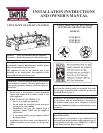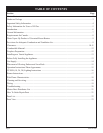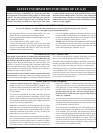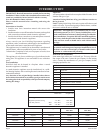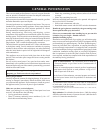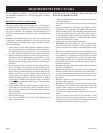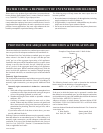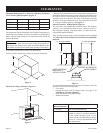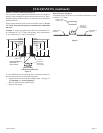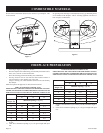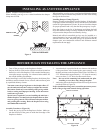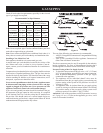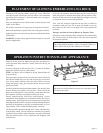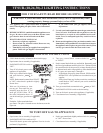
25741-0-0309 Page 9
Example of Large Room with 1/2 Wall divider.
The following formula can be used to determine the maximum
If the area in which the heater may be operated is smaller than
and ventilation air by one of the methods described in the National
Fuel Gas Code, ANSI Z223.1, Section 5.3.
Adhere to all codes, or in their absence, the latest edition of THE
NATIONAL FUEL GAS CODE ANSI Z223.1 or NFPA54 which
can be obtained from:
American National Standards Institute National Fire Protection
Association, Inc.
11 West 42nd St. Batterymarch Park
New York, NY 10018 Quincy, MA 02269
Water vapor is a by-product of gas combustion. An unvented room
heater produces approximately one (1) ounce (30ml) of water for
Unvented room heaters must be used as supplemental heat (a
room) rather than a primary heat source (an entire house). In most
supplemental heat applications, the water vapor does not create a
problem. In most applications, the water vapor enhances the low
humidity atmosphere experienced during cold weather.
The following steps will help insure that water vapor does not
become a problem.
1. Be sure the heater is sized properly for the application, including
ample combustion air and circulation air.
help lower the water vapor content of the air.
3. Do not use an unvented room heater as the primary heat source
(an entire house).
-
sions are provided for adequate combustion and ventilation air.
whose volume is less than 50 cubic feet per 1,000 Btu per hour
(4.8m
3
per kw) of the aggregate input rating of all appliances
volume is not less than 50 cubic feet per 1,000 Btu per hour
(4.8 m
3
per kw) of the aggregate input rating of all appliances
installed in that space. Rooms communicating directly with the
space in which the appliances are installed, through openings
space.
The air that leaks around doors and windows may provide enough
fresh air for combustion and ventilation. However, in buildings of
unusually tight construction, you must provide additional fresh
air.
a. Walls and ceilings exposed to the outside atmosphere have
a continuous water vapor retarder with a rating of one perm
or less with openings gasketed or sealed, and
b. Weather-stripping has been added on openable windows
and doors, and
c. Caulking or sealants are applied to areas such as joints
around window and door frames, between sole plates and
penetrations for plumbing, electrical, and gas lines, and at
other openings.
If your home meets all of the three criteria above, you must
provide additional fresh air.
Warning: If the area in which the heater may be operated is smaller
unusually tight construction, provide adequate combustion and
ventilation air by one of the methods described in the National
Fuel Gas Code, ANSI Z223.1, Section 5.3., International Fuel Gas
Code, or applicable local codes.
FIREPLACE
DIVIDER
H
W
L1
L2
Btu/Hr = (L
1
+ L
2
)FT x (W)FT x (H)FT x 1000
50



